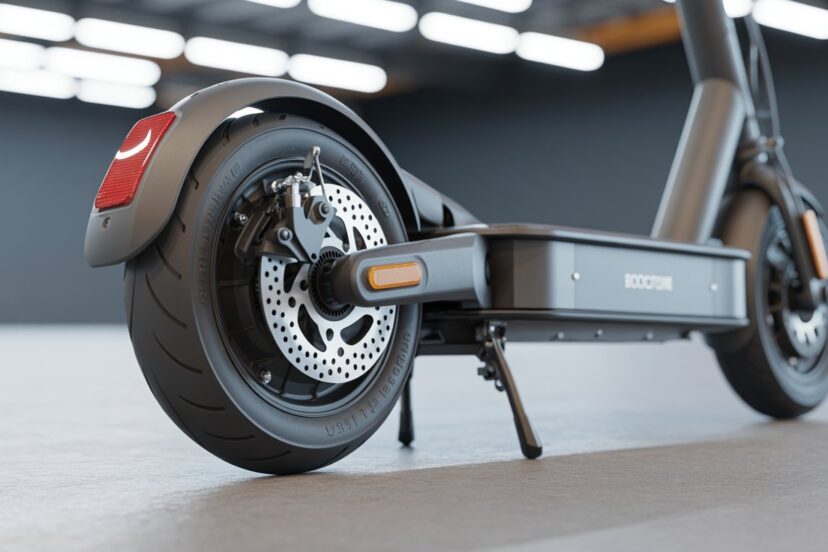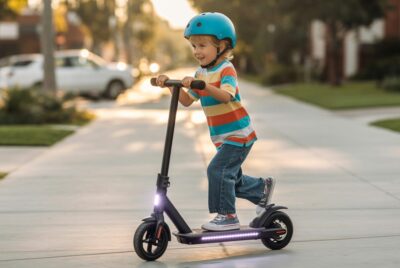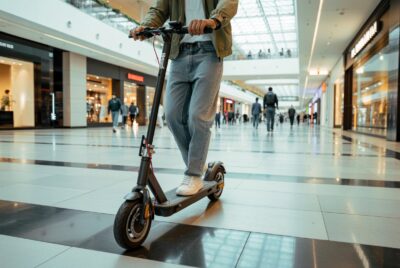Disc Brakes vs. Drum Brakes on E-Scooters – Which Is Safer?
*We may earn a commission for purchases made using our links. Please see our disclosure to learn more.
The sudden screech of brakes, the heart-pounding moment when you realize you need to stop immediately – every e-scooter rider has experienced that critical instant when your braking system becomes the difference between safety and disaster. As e-scooters continue to revolutionize urban transportation, understanding the safety implications of your brake choice has never been more crucial.
Whether you’re navigating busy city streets, cruising through suburban neighborhoods, or tackling steep hills, your braking system serves as your primary safety mechanism. The debate between disc brakes and drum brakes isn’t just about mechanical preferences – it’s about protecting yourself and others on every ride.
“The effectiveness of your braking system directly correlates with your ability to control speed and avoid accidents. In emergency situations, every millisecond of stopping distance matters.”
– National Highway Traffic Safety Administration
Key Takeaways
- Disc brakes offer superior stopping power and heat dissipation, making them ideal for high-performance riding and emergency situations
- Drum brakes provide reliable, low-maintenance performance but may struggle with heat buildup during prolonged braking
- Weather conditions significantly impact brake performance, with disc brakes generally performing better in wet conditions
- Your riding style and environment should determine which brake system best suits your safety needs
- Proper maintenance is crucial for both brake types to ensure optimal safety performance
Understanding E-Scooter Braking Systems
The world of e-scooter braking technology has evolved dramatically over the past decade. What once seemed like a simple choice between two mechanical systems has become a complex decision involving safety, performance, maintenance, and riding conditions.
Modern e-scooters employ various braking mechanisms, but disc and drum brakes remain the most prevalent mechanical options. Each system operates on fundamental principles of friction, yet their design differences create distinct advantages and limitations that directly impact rider safety.
The Anatomy of Disc Brakes
Disc brake systems consist of a rotor attached to the wheel hub, brake calipers that house brake pads, and a hydraulic or cable-actuated system that applies pressure. When you engage the brake lever, the pads clamp down on the spinning rotor, creating friction that converts kinetic energy into heat energy, ultimately stopping the wheel.
The exposed design of disc brakes allows for excellent heat dissipation, preventing brake fade during extended braking periods. This open architecture also facilitates easier inspection and maintenance, allowing riders to visually assess pad wear and rotor condition without disassembly.
The Mechanics of Drum Brakes
Drum brake systems feature brake shoes housed within a cylindrical drum attached to the wheel hub. When activated, the brake shoes expand outward against the inner surface of the drum, creating friction that slows the wheel. This enclosed design protects the braking components from environmental elements like water, dirt, and debris.
The self-contained nature of drum brakes means they require less frequent maintenance and adjustment compared to their disc counterparts. However, this same enclosed design can lead to heat buildup during intensive braking, potentially reducing stopping effectiveness.
Safety Performance Comparison
Stopping Power and Response Time
In terms of raw stopping power, disc brakes consistently outperform drum brakes across various testing conditions. The mechanical advantage provided by the caliper design, combined with the larger surface area contact between pad and rotor, translates to shorter stopping distances and more immediate brake response.
Emergency braking scenarios particularly highlight this performance difference. When faced with sudden obstacles or traffic situations, disc brakes provide the instantaneous stopping power that can prevent accidents. The progressive feel of disc brakes also allows for more precise speed control, enabling riders to modulate their stopping force according to conditions.
Drum brakes, while adequate for normal riding conditions, may struggle to provide the same level of emergency stopping power. The expanding shoe mechanism inherently has a slight delay compared to the direct clamping action of disc brakes, which could prove critical in split-second decision scenarios.
Heat Management and Brake Fade
One of the most significant safety considerations involves brake fade – the reduction in stopping power caused by excessive heat buildup. Disc brakes excel in this area due to their open design, which allows air to flow freely around the rotor, dissipating heat efficiently.
During long descents or repeated hard braking, this heat management advantage becomes crucial. Overheated brakes can lose significant stopping power, creating dangerous situations where riders find themselves unable to slow down effectively.
Drum brakes, with their enclosed design, are more susceptible to heat retention. While this design protects components from contamination, it also traps heat within the drum, potentially leading to brake fade during demanding conditions. This characteristic makes drum brakes less suitable for aggressive riding styles or challenging terrain.
Weather Performance and Reliability
Wet weather conditions reveal another critical safety difference between brake systems. Disc brakes, particularly those with proper rotor designs, shed water quickly and maintain consistent stopping power in rain or wet conditions. The squeegee effect of the brake pads helps clear water from the rotor surface with each brake application.
Drum brakes face unique challenges in wet conditions. While their enclosed design prevents water from directly contacting the friction surfaces, it also prevents quick water evacuation if moisture does enter the system. Additionally, drum brakes may experience reduced effectiveness immediately after riding through puddles or in heavy rain.
Real-World Safety Scenarios
Urban Commuting Challenges
City riding presents unique braking challenges that highlight the safety differences between disc and drum systems. Stop-and-go traffic requires frequent, moderate braking that can quickly heat up brake components. The superior heat dissipation of disc brakes makes them more reliable for urban commuters who face multiple traffic lights, crosswalks, and unexpected stops throughout their journey.
Navigating around pedestrians, cyclists, and vehicles demands precise speed control. The progressive feel and immediate response of disc brakes provide urban riders with the confidence to navigate complex traffic situations safely. The ability to modulate braking force precisely helps prevent both under-braking and over-braking scenarios that could lead to accidents.
Hill Descent Safety
Steep descents represent one of the most demanding scenarios for e-scooter braking systems. The combination of gravity, speed, and extended braking duration can quickly overwhelm inadequate brake systems. Disc brakes shine in these conditions, maintaining consistent stopping power even during long descents.
Riders using drum brakes on steep hills often experience diminishing brake performance as heat builds up within the drum. This brake fade can create frightening situations where riders find themselves accelerating down hills despite applying maximum braking force. The safety implications of brake fade in these scenarios cannot be overstated.
Emergency Braking Situations
Perhaps the most critical safety scenario involves emergency braking – those split-second moments when immediate stopping power means the difference between safety and collision. Disc brakes provide superior emergency stopping capability due to their immediate response and maximum stopping power.
The mechanical advantage of disc brake calipers allows riders to generate maximum stopping force with less hand strength, which proves crucial when adrenaline affects fine motor control during emergencies. The consistent bite point and progressive feel help riders apply maximum braking force without wheel lockup, maintaining control during panic stops.
Maintenance and Long-Term Safety
Disc Brake Maintenance Requirements
Maintaining disc brakes for optimal safety requires regular attention to several key components. Brake pad inspection should occur monthly, checking for wear indicators and replacing pads before they reach minimum thickness. Rotor condition also requires monitoring for warping, scoring, or excessive wear that could compromise braking performance.
The open design of disc brakes makes maintenance straightforward, allowing riders to perform visual inspections without tools. However, this accessibility also means more frequent cleaning and adjustment may be necessary, particularly for riders in dusty or dirty environments.
Drum Brake Maintenance Considerations
Drum brakes typically require less frequent maintenance due to their protected design. Brake shoe replacement intervals are generally longer than disc brake pad intervals, and the enclosed system protects components from environmental contamination that could affect performance.
However, when drum brake maintenance is required, it often involves more complex procedures. Accessing brake shoes for inspection or replacement typically requires wheel removal and drum disassembly, making routine maintenance less convenient for most riders.
Safety Through Proper Maintenance
Regardless of brake type, maintaining your e-scooter’s braking system in peak condition is essential for safety. Neglected brakes pose serious risks, from reduced stopping power to complete brake failure. Regular inspection schedules, proper adjustment procedures, and timely component replacement form the foundation of brake safety.
Understanding the warning signs of brake problems – unusual noises, reduced stopping power, spongy feel, or visual wear indicators – helps riders address issues before they become safety hazards. Professional brake service, when needed, ensures that safety-critical systems receive proper attention from qualified technicians.
Environmental Impact on Brake Choice
Climate Considerations
Different climates present unique challenges for e-scooter braking systems. Hot, dry climates may accelerate brake pad and shoe wear while potentially affecting heat dissipation. Cold climates can impact brake fluid viscosity in hydraulic systems and may cause temporary performance reductions until components warm up.
Humid environments pose corrosion risks for both brake types, though disc brakes may show surface rust on rotors that typically clears with initial use. Salt air in coastal areas requires more frequent cleaning and inspection to prevent corrosion that could compromise safety.
Terrain and Riding Conditions
Your local terrain significantly influences the ideal brake choice for safety. Flat urban areas with minimal elevation changes may not stress either brake type significantly, allowing other factors like maintenance preferences to guide decisions. Hilly terrain demands the superior heat management and stopping power of disc brakes for safe operation.
Off-road or mixed-terrain riding introduces additional variables like dust, dirt, and debris exposure. While drum brakes offer better contamination protection, the superior performance characteristics of disc brakes often outweigh this advantage for safety-conscious riders.
Making the Right Choice for Your Safety
Assessing Your Riding Profile
Determining which brake system best serves your safety needs requires honest assessment of your riding patterns, environment, and priorities. Aggressive riders who frequently tackle hills, ride in traffic, or demand maximum performance should prioritize disc brakes for their superior stopping power and heat management.
Casual riders in flat areas who prioritize low maintenance and adequate performance may find drum brakes sufficient for their safety needs. However, even casual riders benefit from the enhanced emergency stopping capability of disc brakes when unexpected situations arise.
Budget and Safety Balance
While initial cost differences between brake systems may influence purchasing decisions, safety should remain the primary consideration. The relatively small cost difference between disc and drum brake-equipped e-scooters pales in comparison to the potential costs – financial and personal – of brake-related accidents.
Consider the long-term value proposition of your brake choice. Superior safety performance, better emergency stopping capability, and enhanced rider confidence justify the investment in disc brake systems for most riders.
Technology and Future Developments
Brake System Innovations
The e-scooter industry continues evolving brake technology to enhance safety and performance. Advanced disc brake designs incorporate features like larger rotors for increased heat dissipation, improved pad compounds for better wet weather performance, and enhanced caliper designs for more consistent feel and power.
Drum brake technology has also seen improvements, with better heat management designs and enhanced shoe compounds. However, the fundamental limitations of the enclosed drum design continue to constrain performance improvements compared to disc brake innovations.
Integration with Electronic Systems
Modern e-scooters increasingly integrate mechanical braking systems with electronic controls and regenerative braking. These hybrid systems can complement mechanical brakes while providing additional safety features like anti-lock functionality and improved energy efficiency.
Understanding how these integrated systems work with your chosen mechanical brake type helps maximize both safety and performance. Proper calibration and maintenance of integrated brake systems requires attention to both mechanical and electronic components.
Conclusion
The choice between disc and drum brakes on e-scooters ultimately comes down to prioritizing safety performance versus maintenance convenience. While both systems can provide adequate stopping power under normal conditions, disc brakes consistently deliver superior safety performance across a wider range of riding scenarios.
For riders who prioritize maximum safety, emergency stopping capability, and consistent performance in varied conditions, disc brakes represent the clear choice. The superior heat management, immediate response, and precise control offered by disc brake systems provide crucial safety advantages that outweigh their slightly higher maintenance requirements.
However, drum brakes remain a viable option for riders in specific situations – those who ride casually in flat areas, prioritize minimal maintenance, or have budget constraints. Even in these cases, riders should understand the performance limitations and adjust their riding accordingly to maintain safety.
Regardless of your brake choice, remember that proper maintenance, appropriate riding techniques, and awareness of your system’s limitations form the foundation of e-scooter safety. Regular inspection, timely component replacement, and professional service when needed ensure that your braking system continues protecting you mile after mile.
The evolution of e-scooter technology continues advancing safety and performance, but the fundamental importance of reliable braking remains constant. Choose the system that best matches your riding needs, maintain it properly, and ride with confidence knowing you’ve made an informed decision about this critical safety component.
Frequently Asked Questions
Q: How often should I replace brake pads on disc brakes versus brake shoes on drum brakes?
A: Disc brake pads typically require replacement every 1,000-3,000 miles depending on riding conditions and pad material, while drum brake shoes generally last 2,000-5,000 miles. However, inspection frequency should be monthly for both systems, as wear rates vary significantly based on riding style, terrain, and environmental conditions.
Q: Can I upgrade my e-scooter from drum brakes to disc brakes?
A: Brake system upgrades are possible but often require significant modifications including new wheel hubs, brake mounts, and cable routing. The complexity and cost typically make it more practical to purchase an e-scooter with your preferred brake system initially rather than retrofitting.
Q: Do disc brakes work better than drum brakes in wet weather?
A: Yes, disc brakes generally perform better in wet conditions due to their open design that allows water to be quickly expelled from the braking surface. Drum brakes may experience temporary performance reduction in wet conditions until any trapped moisture evaporates.
Q: Which brake system requires less maintenance over time?
A: Drum brakes typically require less frequent maintenance due to their protected design that shields components from environmental contamination. However, when drum brake service is needed, it’s often more complex and time-consuming than disc brake maintenance, which can be performed more easily due to accessible components.
Q: Are there any safety certifications I should look for when choosing brake systems?
A: Look for e-scooters that meet relevant safety standards such as UL 2272 certification, which includes braking performance requirements. Additionally, reputable manufacturers often exceed minimum standards and provide detailed specifications for brake performance, including stopping distances and fade resistance ratings.




